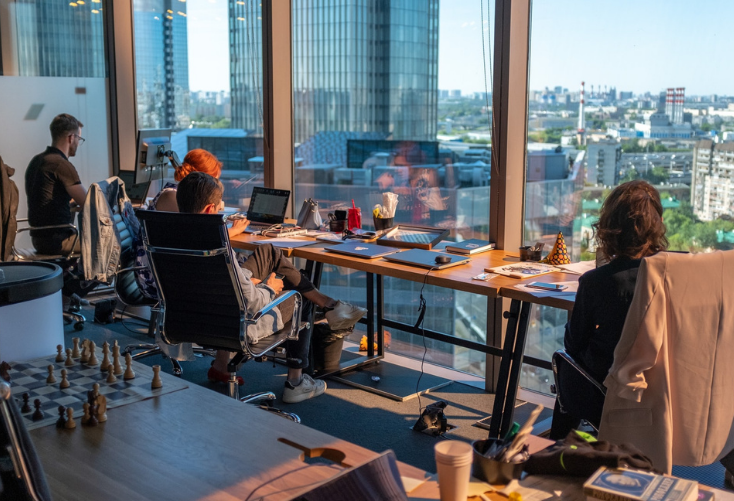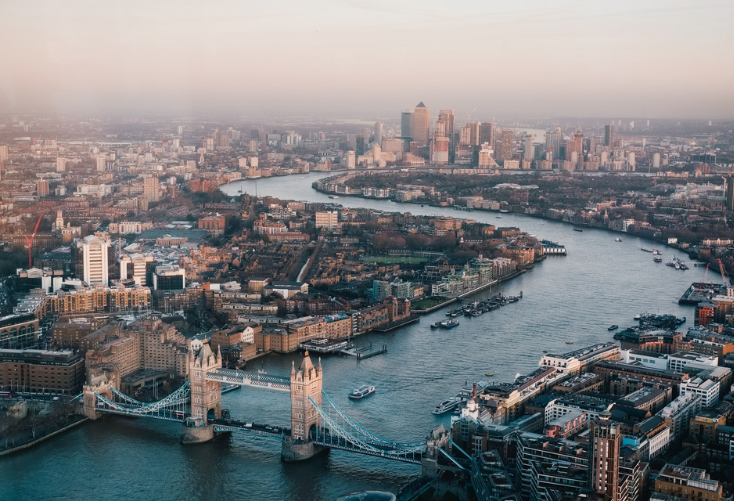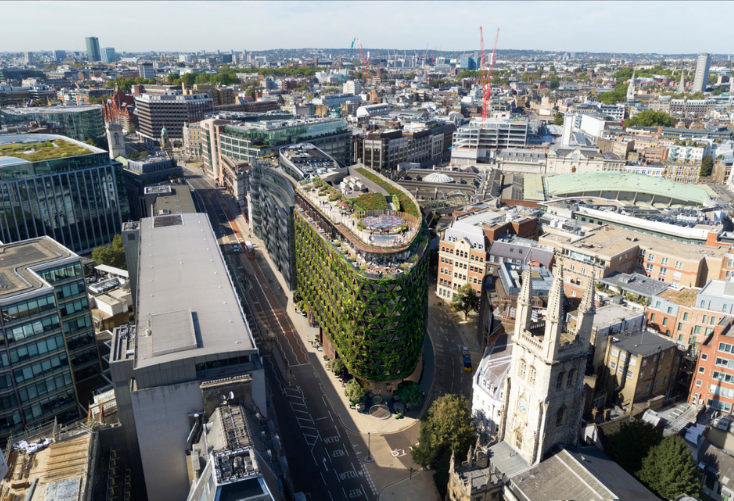- The wellness lens can be applied more widely to communities and the infrastructure that underpins them – including workspaces.
- A “well” workspace is one that doesn’t deplete resources.
- Green offices also attract more occupiers; including a growing section of the workforce who want to work for an organisation that is committed to protecting the environment.
We tend to talk about wellness in relation to the individual. How can I achieve a work-life balance? What can I do to make myself feel more positive? After spending so much time in relative isolation, it’s easy to forget that the wellness lens can be applied more widely to communities and the infrastructure that underpins them – including workspaces.

(Photo credit: Ant Rozetsky)
Generally speaking, we’d define a “well” workspace as one that doesn’t deplete resources. It lives in equilibrium with its local community, economy and natural environment, seizing opportunities to contribute positively to these things whenever it can.
A building that is “well” strives to:
- Achieve net zero carbon emissions as soon as possible or by 2050 at the latest (UK target) – this applies to the project’s development, refurbishment and operations.
- Provide growth opportunities for those who live within the local community, i.e. employment, skills training and business support.
- Support the local economy by buying local, whether it’s locally baked bread, the services of a local contractor or local fitness classes.
- Be diverse, inclusive and equitable by standing out, reaching out and making valuable local, national and international connections.
As you may already have guessed, this article focuses on the first point.
“Well” buildings shouldn’t be confused with WELL-certified buildings, although they both exist in the same ballpark. WELL is an international organisation that creates design strategies informed by scientific research; practices that buildings can put in place to foster a culture of health and wellness. Its framework is called the WELL Building Standard.
WELL sets performance standards for design interventions, operational protocols and policies. Buildings that sign up to the certification earn points based on their performance outcomes. Four certification levels are available: Bronze, Silver, Gold or Platinum.
What does a “well” workspace look like?
A workspace could look cutting edge and eco-friendly on the outside but be seriously unwell on the inside. That’s because aesthetics don’t determine how well a building is – its infrastructure does (as do its business practices and choices).
As most of us know, achieving wellness is a process; and one that isn’t always linear. For example, as individuals, we have to work at wellness because our expectations have a tendency to shift and evolve. Sustainable building standards are always evolving too, so conscious workspace operators need to be prepared to adapt.
WELL Building Standard’s recent evolution is a good case in point. In May 2018, the WELL v2 pilot was released. Co-created with its community, this version is described by WELL as a “leap forward for our standard”. This new and improved iteration was released in June 2020.
Here are a few elements that can constitute an eco-well building today. Although many new eco-buildings are built from the ground-up, it’s also possible to retrofit an existing building to make it more sustainable.
- Green Building Certification such as LEED (Leadership in Energy and Environmental Design) or BREEAM (Building Research Establishment Environmental Assessment Method)
- Sustainable/renewable/recycled materials – for build, fit out/renovation
- Energy analysis software
- Motion activated lights
- LED lighting
- Solar panels/green energy plan
- Utilisation of natural light
- Biophilia
- Geothermal HVAC system
- Smart thermostat to control the HVAC system
- HVAC Zoning: Zoning allows you to create multiple heating and cooling zones, and control each one separately.
- HVAC economiser that draws cooler outside air into the office space
- Recycling system for team and members
- Bike racks to encourage cycling

(Photo credit: Benjamin Davies)
Recent examples of eco-friendly (well) buildings
Stories about new and sustainable office projects – or projects that focus on at least one aspect of sustainability – are hitting the press every day. Let’s take a look at a handful of stories from March 2021.
1. Citicape House
The 0.2ha mixed use site will provide 3,741m² of office space, as well as a hotel with restaurant and bar and a publicly accessible rooftop terrace. A 3,700m² “green wall” made up of around 400,000 plants will cover the building’s façade and public viewing gallery.
Importantly, this new living, breathing cladding system is set to provide seven tonnes of fresh air and extract nine tonnes of CO2 annually.

2. Welcome, feeling at work
Currently under construction in Milan, “Welcome, feeling at work” puts employee health and sustainability at the forefront. The space, which is scheduled to open in 2024, is designed by Kengo Kuma & Associates and commissioned by Europa Risorse.
It’s been cited as one of the most sustainable office developments thus far. The project is focusing on zero carbon emissions, renewable energy resources, consumption control, salvaging of water, green areas and endemic species.
The project’s zero carbon emissions goal will be enabled, in part, by the building’s heating and cooling system and the use of solar panels. The team is also aiming for Platinum WELL certifications with a Platinum LEED energy efficiency.
3. BE.Spoke (part of the BE Offices Group)
The Mayor of London, Sadiq Khan, has unveiled details of the Business Climate Challenge, a programme to help businesses tackle the climate emergency. (London’s goal is to reach net-zero carbon emissions by 2030.) As it stands, 36 per cent of the UK capital’s carbon footprint is caused by emissions from powering and heating commercial/industrial buildings.
Businesses that sign up to the challenge are pledging to reduce energy across their buildings (10% in the first year). One of the most iconic buildings to sign up to the pilot scheme in Southwark so far is Shakespeare’s Globe theatre. IThe theatre is joined by flexible workspace operator BE.Spoke and others.
Why invest in the wellness of your building?
The obvious reason is to help the planet, but there are lots of business-related incentives too. Firstly, going green has the potential to add significant value.
Analysis by JLL of leasing activity in new Central London offices found those with a BREEAM rating of very good or above achieved higher rents. The average rental premium over the last three years was 8 per cent more in rated buildings than non-rated ones.
Green offices also attract more occupiers; including a growing section of the workforce who want to work for an organisation that is committed to protecting the environment.
“A BREEAM rating is not the sole factor for low vacancy or increased rents, more so a contributing factor among other market fundamentals,” says Elaine Rossall, Head of UK Offices Research at JLL.
“However, given the increasing prevalence of corporate mandates toward sustainability, BREEAM is becoming a more prominent deciding factor and for some tenants, a prerequisite for their new location.”
In other words, if you neglect the wellness of your building, you will get left behind.


 Dr. Gleb Tsipursky – The Office Whisperer
Dr. Gleb Tsipursky – The Office Whisperer Nirit Cohen – WorkFutures
Nirit Cohen – WorkFutures Angela Howard – Culture Expert
Angela Howard – Culture Expert Drew Jones – Design & Innovation
Drew Jones – Design & Innovation Jonathan Price – CRE & Flex Expert
Jonathan Price – CRE & Flex Expert














